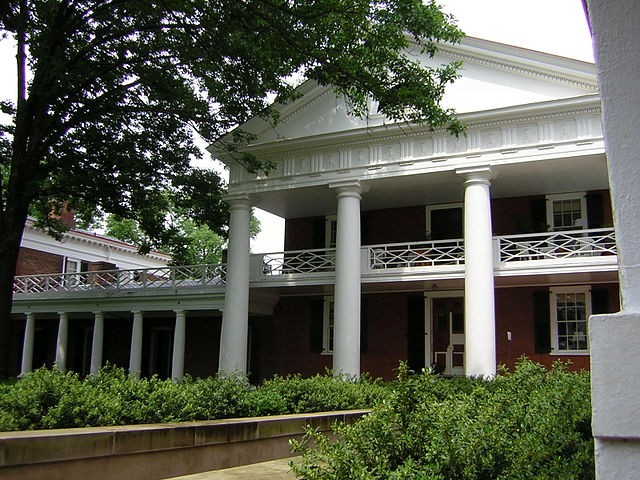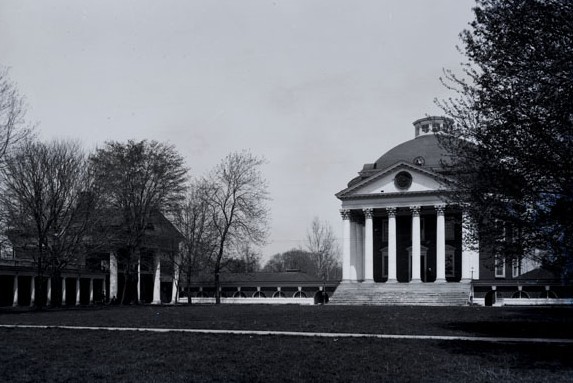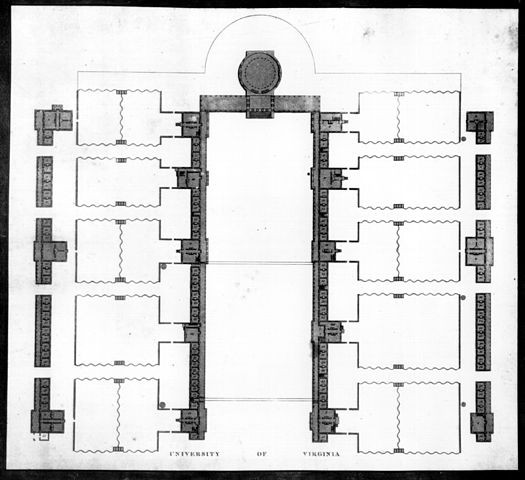Pavilion I
Introduction
Text-to-speech Audio
Pavilion I is a historic building located within Thomas Jefferson's Academical Village at the University of Virginia. The structure adjoins the steps of the Rotunda steps on the west side. Completed in 1822, it was the fifth pavilion to be constructed. It features columnns topped by Doric capitals, central doorways on the first two floors, and a center chimney. It is distinguished by the Chinese-inspired trellis on its second floor.
Images
Pavilion I Facade, West Lawn

University of Virginia: The Rotunda and Pavilion I as seen from the Lawn in or before 1895

Engraving by Peter Maverick of the plan of the University of Virginia, after Jefferson's drawing, 1826.

Backstory and Context
Text-to-speech Audio
The Pavilions are located along the east and west sides of the University of Virginia's Academical Village. Centered around the Lawn, the Academical Village was designed by Thomas Jefferson as a unique environment where scholars would live and study in an architecturally unified space. The ten pavilions each represent an academic discipline, an order of ancient architecture, and were intended to recognize the dignity of each subject.
Pavilion I is characterized by its four plastered white-painted columnns, topped by Doric capitals manufactured in Charlottesville, Virginia. The Chinese-inspired trellis on the second floor was designed by Jefferson himself. Pavilion I's first occupant was John Patton Emmet, professor of natural history, who taught chemistry, botany, and comparative anatomy. His botanical experiments included growing grapes, rare flours, fruit trees, and Chinese mulberries on which to raise silkworms. The garden soon overgrew the available space. In response, Emmet purchased property near the pavilion; it is still called "Morea" after the botanical name for mulberry.
In 1997, the morning of the graduation ceremony commencement, the balcony on the second level of Pavilion I collapsed. Investigations into the matter revealed that the cause was a single corroded wrought iron tension rod and a lack of redundancies in the design. As the rod was concealed within a supporting wooden beam, there were no visible signs of the corrosion prior to the collapse. In response, the rods were replaced by ones made of stainless steel that look identical to the originals.
Pavilion I is characterized by its four plastered white-painted columnns, topped by Doric capitals manufactured in Charlottesville, Virginia. The Chinese-inspired trellis on the second floor was designed by Jefferson himself. Pavilion I's first occupant was John Patton Emmet, professor of natural history, who taught chemistry, botany, and comparative anatomy. His botanical experiments included growing grapes, rare flours, fruit trees, and Chinese mulberries on which to raise silkworms. The garden soon overgrew the available space. In response, Emmet purchased property near the pavilion; it is still called "Morea" after the botanical name for mulberry.
In 1997, the morning of the graduation ceremony commencement, the balcony on the second level of Pavilion I collapsed. Investigations into the matter revealed that the cause was a single corroded wrought iron tension rod and a lack of redundancies in the design. As the rod was concealed within a supporting wooden beam, there were no visible signs of the corrosion prior to the collapse. In response, the rods were replaced by ones made of stainless steel that look identical to the originals.
Sources
Singleton, Maura. "At Home in History: Pavilion residents bring personal touches to revered buildings." University of Virginia Magazine, Fall 2011. http://uvamagazine.org/articles/at_home_in_history/P2.
"The Lawn." Wikipedia, the Free Encyclopedia. Accessed March 19, 2017. http://en.wikipedia.org/wiki/The_Lawn.
"U.Va. Web Map: Pavilion I." The University of Virginia. Accessed March 20, 2017. http://www.Virginia.edu/webmap/popPages/pavilion1.html.
"University of Virginia Historic Balcony Collapse." Failures. Accessed March 20, 2017. http://failures.wikispaces.com/University+of+Virginia+Historic+Balcony+Collapse.
Maverick Engraving; image from http://repo.lib.Virginia.edu:18080/fedora/get/uva-lib:81674/uva-lib-bdef:100/viewCitation?style=, Public Domain, https://commons.wikimedia.org/w/index.php?curid=4744210.
Pavilion I; image by Timothy Jarrett from Arlington, MA, USA - flickr, CC BY-SA 2.0, https://commons.wikimedia.org/w/index.php?curid=5290050.
Rotunda from the Lawn; image uploaded and edited by Ibn Battuta - University of Virginia Visual History Collection, Public Domain, https://commons.wikimedia.org/w/index.php?curid=1819706.
"The Lawn." Wikipedia, the Free Encyclopedia. Accessed March 19, 2017. http://en.wikipedia.org/wiki/The_Lawn.
"U.Va. Web Map: Pavilion I." The University of Virginia. Accessed March 20, 2017. http://www.Virginia.edu/webmap/popPages/pavilion1.html.
"University of Virginia Historic Balcony Collapse." Failures. Accessed March 20, 2017. http://failures.wikispaces.com/University+of+Virginia+Historic+Balcony+Collapse.
Maverick Engraving; image from http://repo.lib.Virginia.edu:18080/fedora/get/uva-lib:81674/uva-lib-bdef:100/viewCitation?style=, Public Domain, https://commons.wikimedia.org/w/index.php?curid=4744210.
Pavilion I; image by Timothy Jarrett from Arlington, MA, USA - flickr, CC BY-SA 2.0, https://commons.wikimedia.org/w/index.php?curid=5290050.
Rotunda from the Lawn; image uploaded and edited by Ibn Battuta - University of Virginia Visual History Collection, Public Domain, https://commons.wikimedia.org/w/index.php?curid=1819706.
